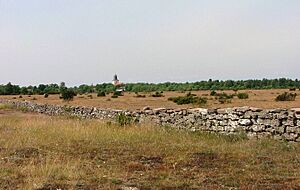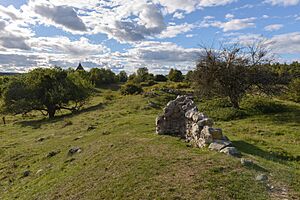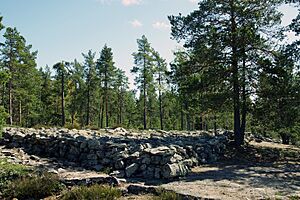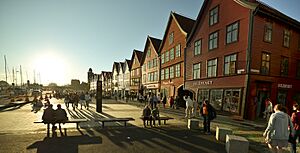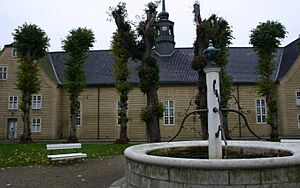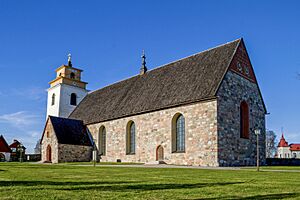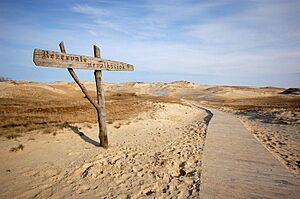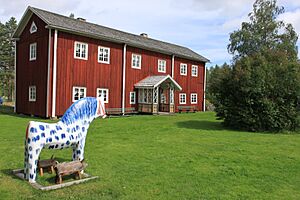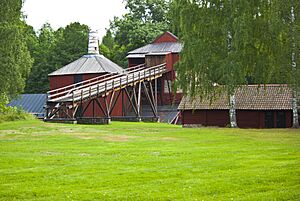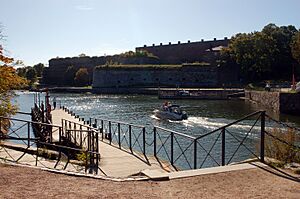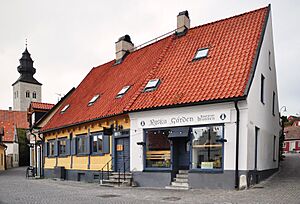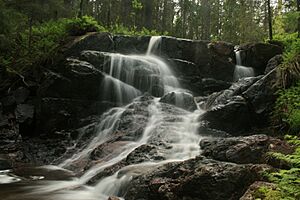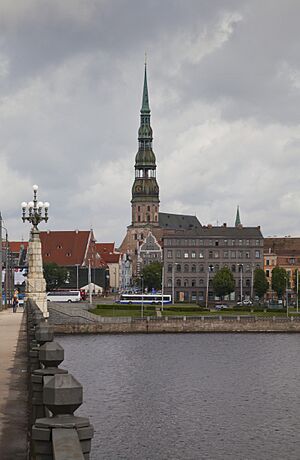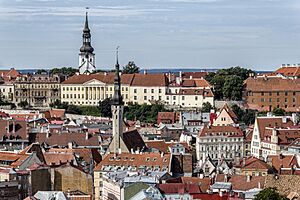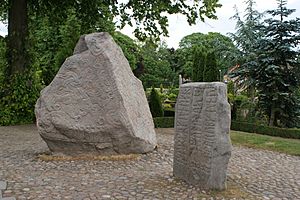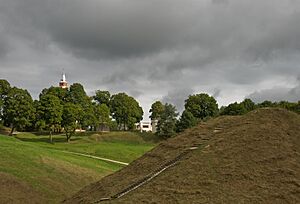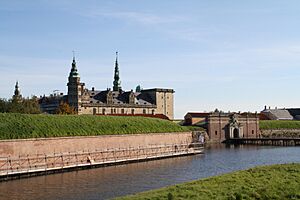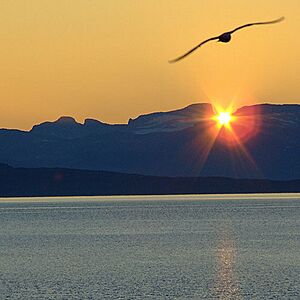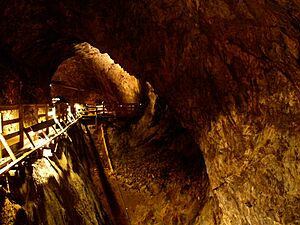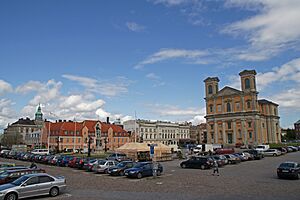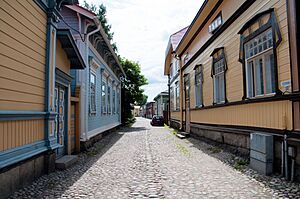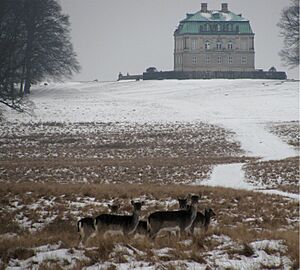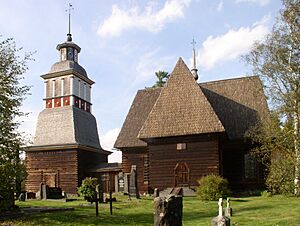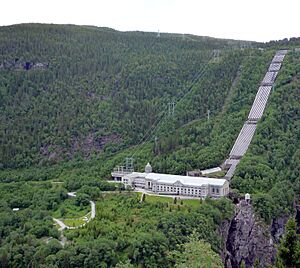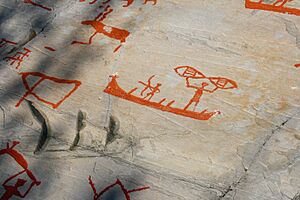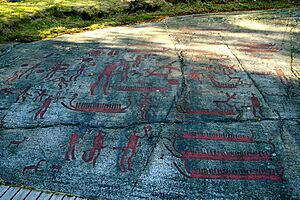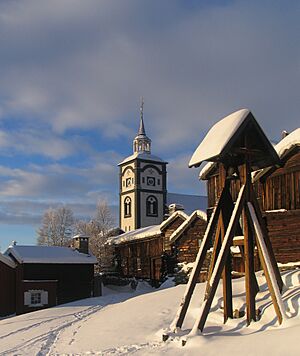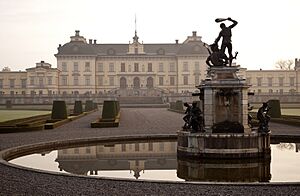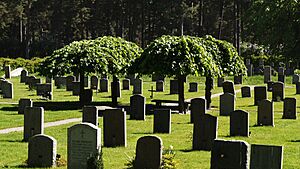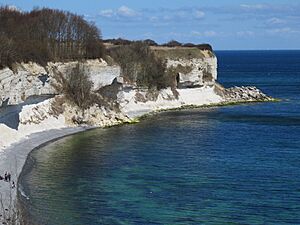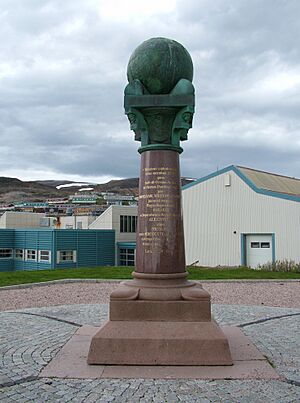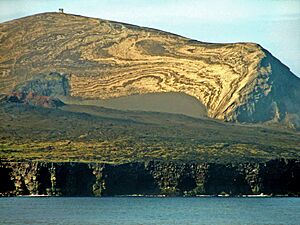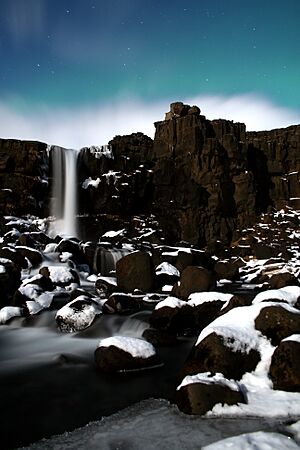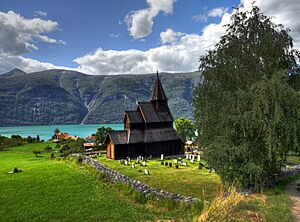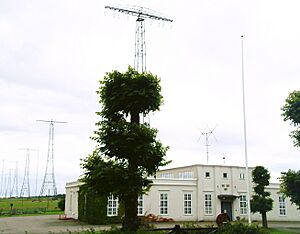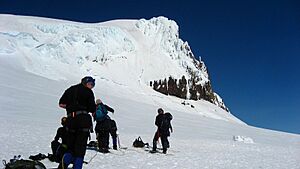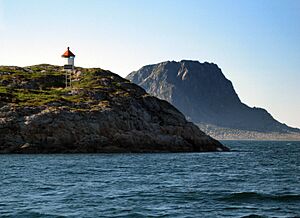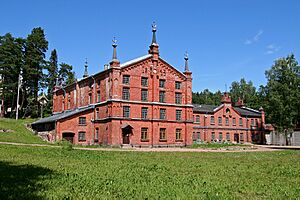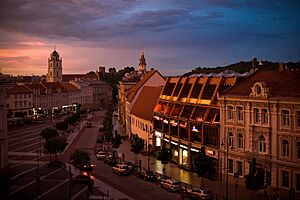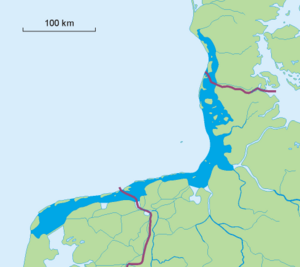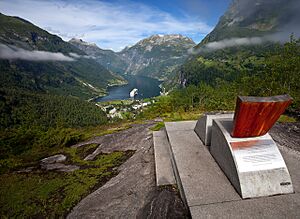List of World Heritage Sites in Northern Europe facts for kids
The UNESCO (United Nations Educational, Scientific and Cultural Organization) is a special part of the United Nations. It helps protect important places around the world. These places are called World Heritage Sites. They are chosen because they have amazing cultural or natural value.
Northern Europe has 37 World Heritage Sites. These sites are found in eight countries: Iceland, Norway, Sweden, Finland, Denmark, Estonia, Latvia, and Lithuania. These countries are a mix of Nordic and Baltic nations. The Faroe Islands, which belong to Denmark, do not have any sites. Greenland is not on this list because it's considered part of North America. The United Kingdom and Ireland are usually grouped with Western Europe.
Sweden has the most sites, with 15 in total. Some sites are shared between countries. For example, the Curonian Spit is in both Lithuania and Russia. The High Coast / Kvarken Archipelago is shared by Sweden and Finland. The Struve Geodetic Arc is a huge scientific project that spans ten countries!
The first sites in Northern Europe were chosen in 1979. These were the Urnes Stave Church and Bryggen, both in Norway. UNESCO's World Heritage Committee decides which new sites to add each year. They also remove sites that no longer meet the rules. Sites are picked based on ten special rules. Six rules are for cultural heritage (like old buildings or traditions). Four rules are for natural heritage (like unique landscapes). Some sites are "mixed," meaning they have both cultural and natural importance. In Northern Europe, there are 32 cultural sites, 4 natural sites, and 1 mixed site.
The World Heritage Committee can also list a site as "endangered." This means the site is in danger of being harmed. Luckily, no sites in Northern Europe have ever been listed as endangered.
Contents
Amazing World Heritage Sites in Northern Europe
Here's a look at some of the incredible World Heritage Sites in Northern Europe.
| Site Name | Picture | Location | Type of Heritage | Size (hectares) |
Year Added | What Makes It Special |
|---|---|---|---|---|---|---|
| Agricultural Landscape of Southern Öland | Kalmar, |
Cultural |
|
2000 | This unique limestone plateau on Öland island has been home to people for 5,000 years. They learned to live with the land, creating a special landscape. You can see signs of human life here from ancient times to today. | |
| Birka and Hovgården | Stockholm, |
Cultural |
|
1993 | Birka was a busy Viking trading town in the 9th and 10th centuries. Hovgården is on a nearby island. Together, they show how Vikings traded across Europe. Birka was also where the first Christian church in Sweden was built in 831. | |
| Bronze Age Burial Site of Sammallahdenmäki | Rauma (Lappi), Satakunta, |
Cultural |
|
1999 | This ancient burial site has over 30 granite burial mounds. They teach us a lot about how people in northern Europe buried their dead over 3,000 years ago. It shows their social and religious beliefs. | |
| Bryggen | Bergen, Hordaland, |
Cultural |
|
1979 | Bryggen is the old wharf in Bergen. It reminds us how important Bergen was for trade in the 14th to 16th centuries. Even after many fires, the wooden houses were rebuilt using old ways. This keeps its ancient look, which was common in Northern Europe. | |
| Christiansfeld, a Moravian Church Settlement | Christiansfeld, Kolding Municipality, Southern Denmark, |
Cultural |
|
2015 | Christiansfeld was built in 1773 by the Moravian Church. It's a great example of a planned town based on Protestant ideas. The buildings are simple and uniform. The town's design shows the church's belief in equality. Many buildings are still used by the church community today. | |
| Church Village of Gammelstad, Luleå | Norrbotten, |
Cultural |
|
1996 | Gammelstad is the best example of a "church village." These villages were common in northern Scandinavia. The 424 wooden houses around the 15th-century stone church were used by people who traveled far for church. They stayed overnight because they couldn't go home the same day. | |
| Curonian Spit | Neringa and Klaipėda district, Klaipėda County, |
Cultural |
|
2000 | This long sand dune peninsula is 98 km long. People have lived here since ancient times. It's always been threatened by wind and waves. People have worked hard to stop erosion and plant trees to save it. | |
| Decorated Farmhouses of Hälsingland | Gävleborg, |
Cultural | 14 (35) | 2012 | These seven timber houses in eastern Sweden show a long tradition of wooden building. Rich farmers in the 19th century built grand homes with fancy decorations. The paintings mix folk art with popular styles of the time, like Baroque. | |
| Engelsberg Ironworks | Västmanland, |
Cultural |
|
1993 | Sweden was a leader in making high-quality iron in the 17th and 18th centuries. This site is the best-preserved example of a Swedish ironworks from that time. It shows how iron was made back then. | |
| Fortress of Suomenlinna | Helsinki, |
Cultural |
|
1991 | Sweden built this fortress in the 18th century on islands at the entrance to Helsinki's harbor. It's a great example of military architecture from that period in Europe. | |
| Hanseatic Town of Visby | Gotland, |
Cultural |
|
1995 | Visby was a Viking site and a main trading center for the Hanseatic League in the Baltic Sea from the 12th to 14th centuries. Its 13th-century walls and over 200 old buildings make it the best-preserved fortified trading city in northern Europe. | |
| High Coast / Kvarken Archipelago | Västernorrland, |
Natural | 194,400 (480,000) | 2000 | These areas in the Gulf of Bothnia show how land rises from the sea very quickly. This happens after glaciers melt. You can see how the land has changed over thousands of years. It's one of the fastest land uplifts in the world. | |
| Historic Centre of Riga | Riga, |
Cultural | 438 (1,080) | 1997 | Riga was a big trading hub for the Hanseatic League. Its medieval center shows this wealth. In the 19th century, Riga became an important economic city. It has some of the best Art Nouveau buildings in Europe. | |
| Historic Centre (Old Town) of Tallinn | Tallinn, Harju County, |
Cultural | 113 (280) | 1997 | Tallinn started in the 13th century when a castle was built. It became a major Hanseatic League center. Its wealth is clear in the beautiful churches and merchant houses. Many have survived fires and wars over centuries. | |
| Jelling Mounds, Runic Stones and Church | Jelling, Vejle Municipality, Southern Denmark, |
Cultural | 4.96 (12.3) | 1994 | The Jelling burial mounds and one runic stone show ancient Nordic culture. Another runic stone and the church show how the Danish people became Christian in the 10th century. | |
| Kernavė Archaeological Site (Cultural Reserve of Kernavė) | Kernavė, Širvintos district, Vilnius County, |
Cultural | 194 (480) | 2004 | This site shows 10,000 years of human life in Lithuania. It has old towns, forts, burial sites, and other historical remains. It was an important medieval town, destroyed in the 14th century, but still used until modern times. | |
| Kronborg Castle | Helsingør, Capital Region, Zealand, |
Cultural |
|
2000 | Kronborg Castle is in a key location between Denmark and Sweden. It was very important in Northern European history from the 16th to 18th centuries. This amazing Renaissance castle, built in 1574, is famous as Elsinore in Shakespeare's Hamlet. | |
| Laponian Area | Norrbotten, |
Mixed | 940,000 (2,300,000) | 1996 | This Arctic Circle region is home to the Saami people. They still move their reindeer herds seasonally. It's one of the last places with this ancient way of life. You can also see how glaciers and water have shaped the land over time. | |
| Mining Area of the Great Copper Mountain in Falun | Dalarna, |
Cultural | 43 (110) | 2001 | The huge Great Pit at Falun shows copper mining activity since the 13th century. The 17th-century town of Falun and other mining remains show what was once one of the world's most important mining areas. | |
| Naval Port of Karlskrona | Blekinge, |
Cultural |
|
1998 | Karlskrona is a great example of a planned naval city from the late 17th century. Its original design and many buildings are still intact. They show how the city grew over time. | |
| Old Rauma | Rauma, Satakunta, |
Cultural | 29 (72) | 1991 | Rauma is one of Finland's oldest harbors. It's a wonderful example of an old Nordic city built with wood. Even after a big fire, it kept its old architectural style. | |
| The par force hunting landscape in North Zealand | Capital Region, Zealand, |
Cultural |
|
2015 | This landscape near Copenhagen was designed for royal hunting. Danish kings used it for "par force" hunting with hounds. The star-shaped hunting lanes and lodges show how Baroque design was used in forests. | |
| Petäjävesi Old Church | Petäjävesi, Central Finland, |
Cultural |
|
1994 | Petäjävesi Old Church was built of logs between 1763 and 1765. This Lutheran church is a unique example of traditional Scandinavian wooden architecture. It mixes Renaissance ideas with older Gothic styles. | |
| Rjukan–Notodden Industrial Heritage Site | Notodden / Rjukan, Telemark, |
Cultural |
|
2015 | This site in Norway has hydroelectric power plants, factories, and towns. It was built to make artificial fertilizer in the early 20th century. It shows how industry and nature can exist together in a dramatic landscape. | |
| Rock Art of Alta | Alta, Finnmark, |
Cultural |
|
1985 | These rock carvings in the Alta Fjord are near the Arctic Circle. They show signs of people living here from about 4200 to 500 B.C. The thousands of paintings and carvings help us understand ancient life in the Far North. | |
| Rock Carvings in Tanum | Västra Götaland, |
Cultural |
|
1994 | The rock carvings in Tanum are a unique artistic treasure. They show humans, animals, weapons, and boats. They tell us about the life and beliefs of people in Europe during the Bronze Age. They are remarkable for their large number and quality. | |
| Røros Mining Town and the Circumference | Røros, Sør-Trøndelag, |
Cultural |
|
1980 | Røros was a copper mining town from the 17th century until 1977. It was rebuilt after being destroyed in 1679. It has about 2,000 wooden houses, many with blackened facades, giving it an old look. It shows how copper mining created a lasting culture in a harsh climate. | |
| Roskilde Cathedral | Roskilde, Region Zealand, Zealand, |
Cultural | 0.40 (0.99) | 1995 | Built in the 12th and 13th centuries, this was Scandinavia's first Gothic cathedral made of brick. It helped spread this style across northern Europe. It has been the burial place for the Danish royal family since the 15th century. It shows how European religious architecture changed over time. | |
| Royal Domain of Drottningholm | Stockholm, |
Cultural |
|
1991 | Drottningholm is on an island near Stockholm. With its castle, old theater (from 1766), Chinese pavilion, and gardens, it's the best example of an 18th-century royal home in northern Europe. It was inspired by the Palace of Versailles. | |
| Skogskyrkogården | Stockholm, |
Cultural |
|
1994 | This cemetery in Stockholm was designed between 1917 and 1920. Two young architects blended nature and buildings. They used the natural landscape to create a beautiful and peaceful place. It has influenced cemetery designs worldwide. | |
| Stevns Klint | Store Heddinge, Zealand, |
Natural | 50 (120) | 2014 | Stevns Klint is a 15 km long chalk cliff full of fossils. It has proof of the ash cloud from the meteorite impact that caused a mass extinction 65 million years ago. It also shows how life recovered after that event. | |
| Struve Geodetic Arc | Cultural |
|
2005 | The Struve Arc is a chain of survey points stretching over 2,820 km through 10 countries. It was used from 1816 to 1855 to measure a long part of the Earth. This helped scientists figure out the exact size and shape of our planet. It shows amazing teamwork between scientists and leaders. | ||
| Surtsey | Vestmannaeyjar, |
Natural | 3,370 (8,300) | 2008 | Surtsey is a new volcanic island that formed off Iceland's coast between 1963 and 1967. It's been protected since its birth, acting as a natural laboratory. Scientists study how plants and animals colonize new land here. They've seen many species arrive and grow over the years. | |
| Þingvellir National Park | Bláskógabyggð, |
Cultural | 9,270 (22,900) | 2004 | Þingvellir National Park is where the Althing, Iceland's open-air assembly, met from 930 to 1798. This assembly made laws and settled arguments. It's very important to Icelandic history. The park still has remains of old booths and shows how the land was used for over 1,000 years. | |
| Urnes Stave Church | Luster, Sogn og Fjordane, |
Cultural |
|
1979 | The wooden Urnes Stave Church was built in the 12th and 13th centuries. It's a great example of traditional Scandinavian wooden architecture. It mixes Celtic art, Viking traditions, and Romanesque styles. | |
| Varberg Radio Station | Halland, |
Cultural | 109 (270) | 2004 | Varberg Radio Station (built 1922–24) is a well-preserved example of early wireless communication across the Atlantic. It has transmitter equipment, including six tall steel towers. It's still in working order and shows how telecommunications developed before electronic technology. | |
| Vatnajökull National Park — dynamic nature of fire and ice | Vatnajökull, |
Natural | 1,482,000 (3,660,000) | 2019 | This huge national park in Iceland shows the powerful forces of fire and ice. It has active volcanoes, massive glaciers, and stunning landscapes shaped by both. | |
| Vegaøyan — The Vega Archipelago | Vega, Nordland, |
Cultural | 103,710 (256,300) | 2004 | This group of islands near the Arctic Circle shows a unique way of life. People here have lived by fishing and collecting eider duck down for 1,500 years. The islands have fishing villages, lighthouses, and special houses for ducks. | |
| Verla Groundwood and Board Mill | Kouvola (Jaala), Kymenlaakso, |
Cultural | 23 (57) | 1996 | The Verla mill and its homes are a great example of small industrial towns. These towns made pulp, paper, and board in northern Europe in the 19th and early 20th centuries. Only a few such places still exist today. | |
| Vilnius Historic Centre | Vilnius, |
Cultural |
|
1994 | Vilnius was the political center of Lithuania from the 13th to 18th centuries. It greatly influenced the culture and architecture of Eastern Europe. Despite wars, it still has amazing Gothic, Renaissance, Baroque, and classical buildings. | |
| Wadden Sea | Natural | 968,393 (2,392,950) | 2009 | The Wadden Sea has flat coastlines with mudflats, marshes, and dunes. It's home to many plants and animals. It's a breeding ground for up to 12 million birds each year! It was expanded in 2014 to include the Danish part. | ||
| West Norwegian Fjords — Geirangerfjord and Nærøyfjord | Møre og Romsdal, |
Natural |
|
2005 | These two fjords in southwestern Norway are among the world's longest and deepest. They are incredibly beautiful, with steep rock walls rising from the sea. They have many waterfalls, forests, and glaciers. |
Future World Heritage Sites?
Many countries in Northern Europe have places on a "tentative list." These are sites they hope will become World Heritage Sites in the future.
Denmark's Potential Sites
- Amalienborg and its area (1993)
- Moler landscape of Limfjord (2010)
- The Maritime Heritage of Dragør Old Town and Harbour (2019)
- Viking Age Ring fortresses (2018)
Estonia's Potential Sites
- Kuressaare Fortress (2002)
- Baltic Klint (2004)
- Wooded meadows (2004)
Finland's Potential Sites
- The Carvings from historic time at the island of Gaddtarmen (Hauensuoli) (1990)
- The large Stone Age ruin of Kastelli at Pattijoki (1990)
- The rock paintings of Astuvansalmi at Ristiina (1990)
- The Holy place of worship of Ukonsaari by the Sami people at Inari (1990)
- Paimio Hospital (formerly Paimio Sanatorium) (2004)
- Saimaa-Pielinen Lake System (2004)
Iceland's Potential Sites
- Breiðafjörður Nature Reserve (2011)
- Mývatn and Laxá (2011)
- Viking monuments and sites/Þingvellir National Park (2011)
- The Turf House Tradition (2011)
- Torfajökull Volcanic System/Fjallabak Nature Reserve (2013)
Latvia's Potential Sites
- Viking Monuments and Sites/Grobiņa archaeological complex (2011)
- Kuldīga Old Town in the Primeval Valley of the River Venta (2011)
- Meanders of the Upper Daugava (2011)
Lithuania's Potential Sites
- Trakai Historical National Park (2003)
- Kaunas 1919-1939: The Capital Inspired by the Moderne Movement (2017)
Norway's Potential Sites
- The Laponian area – Tysfjord, the fjord of Hellenbotn and Rago (extension) (2002)
- The Lofoten Islands (2007)
- Svalbard Archipelago (2007)
- Islands of Jan Mayen og Bouvet as part of a serial transnational nomination of the Mid-Atlantic Ridge System (2007)
- Viking Monuments and Sites/Vestfold Ship Burials and Hyllestad Quernstone Quarries (2011)
Sweden's Potential Sites
- The Rise of Systematic Biology (2009)


